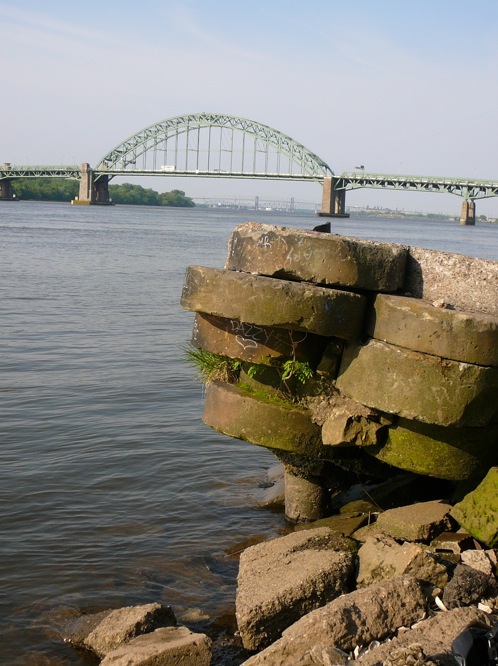
Originally seven feet in diameter, these Disston grindstones became unproductive once worn down to four feet. Hundreds, if not thousands, of them were stacked as bulkhead where Disston fronts on the Delaware River, north of Unruh Street. South is the Tacony Palmyra Bridge. © Torben Jenk, 2007.
TACONY
© Harry C. Silcox, Ed.D.,
Workshop of the World (Oliver Evans Press,
1990).
The first recognition of
Tacony as a community came when William Penn appointed
trading post operator Henry Waldy postmaster for the area
in 1683. Scheduled daily steamers took passengers and
mail from Tacony's Butterworth Hotel wharf throughout the
eighteenth and nineteenth centuries when waterways were
the main means of transportation. In 1844, the people of
Kensington refused to allow trains to run through their
streets making Tacony Philadelphia's terminus for trains
to New York. Between this date and 1860 those wishing to
travel to New York took a boat from Center City's Walnut
Street dock and traveled to Tacony's train station.
The easy access to the city from Tacony made the area a
popular vacation spot and location for country houses of
wealthy Philadelphians. Among those who had summer homes
in the area were men like merchant Caleb Cope,
railroadman William Gatzmer, and umbrella manufacturer
Robert H. Wright. 1
Tacony continued as a resort until after the Civil War
when Henry Disston purchased land for a factory and
community of workers there. Between 1872 and 1906 Tacony
grew from a hamlet of fewer than 200 people to a
community of 12,000. This growth was directly related to
the growth of Keystone Saw Works. The company broke
ground for the Tacony mill in 1872 and thereafter moved
its operations in stages from its plant at Front and
Laurel Streets in Northern Liberties. 2
The moves took
place as follows:
1872 handle shop
1873 file shop
1879 steel workers
1881 long saws
1881 hardening shop
1882 circular saw department
1883 jobbing shop
1884 hand saw department
1885 jobbing shop moved back to Laurel Street
because of inconvenience to customers
1887 square and level department
1896 butcher saw and trowel department
1899 jobbing shop
It was during these years that Disston and Sons Keystone
Saw Works became known by reputation as the largest and
best known saw maker in the world. To add to the
company's reputation an 1886 report by Pennsylvania's
Secretary of Internal Affairs lauded Tacony as the
state's ideal manufacturing town. Planned as a utopian
village by Disston,the town was noted for its clean air
and pure water. From 1900 to 1929 life in Tacony was that
of a factory town with every available convenience.
Houses were built by the company for the workers and sold
or rented to them at reasonable prices. Tacony had its
own water supply, opera house, movie house, parks, bank,
and shopping street. Disston and Sons was the major
economic and social institution in the community. It
sponsored athletic teams, shows, dances, and beneficial
and civic associations.
In 1955 Disston was sold to H.K. Porter of Pittsburgh and
twenty years later a Swedish firm, Sandvik, purchased the
company from Porter. In 1984 Sandvik sold the company to
R.A.F. Industries led by Robert Fox of Jenkintown.
3
The early success of Disston's Saw Factory, and the
presence of skilled craftsmen in Tacony, attracted other
companies to the area. The Tacony Iron Works (1881),
Erben Search textile mill (1885), and the Gillinder Glass
Works (1910) were among the industries who provided the
community alternatives to working at Disston. The
craftsmen in Tacony dictated such decisions on the part
of business.
Today, only the buildings of Disston and Erben Search
still stand. However, the community has many remnants of
Henry Disston's town including Marsden Row at Marsden and
Knorr Streets, Jonathan Marsden's house at Longshore and
Keystone Streets, Superintendent Butterworth's house at
Disston and Tulip Streets, and Magistrate Thomas South's
house at the comer of Disston and Keystone Streets. Also
many of the old store fronts, the bank building, the
opera house, the first movie, all on Longshore Street
between Keystone and Torresdale Avenue, remain today as
symbols of another era. 4
1 Samuel C. Willits,
"History
of Lower Dublin Academy," Vol. 2, Holmesburg Public
Library, Philadelphia, p. 143; J. L. Smith, Atlas of the
23rd, 35th, and 4lst Wards of the Citv of Philadelphia,
(Philadelphia, 1910); 1876 Map of Philadelphia, The Free
Library of Philadelphia, Logan Square, Philadelphia;
Lorin Blodget, Census
of Philadelphia Manufactures, (Philadelphia, 1883).
Blodget compiled this work on the basis of the reports
from the Police Department as ordered by Mayor Samuel G.
King.
2 There is no biography of
Henry Disston. William Dunlap Disston, Henry Disston, and
William Smith wrote "The
Disston History," which was compiled by
Elizabeth B. Satterthwaite in 1920 and can be found at
the Eleutherian Mills Historical Library, Greenville,
Delaware, see pgs. 52-54.
3 Disston, Disston, and
Smith, pgs. 1-100
4 "Tacony
Industries, Smokestacks Tower over Homes Old and
New,” (September 23, 19510: see
also “Tacony:
Grand Celebration at tacony Week of May 30,
1906,” Bulletin Colection, Tacony
Envelope, Urban Archives, Paley Library, Temple
University.
Acknowledgements: William
Rowen, Master Smither, Disston and Sons. Catherine Seed,
Worker, Mary Disston Estate. Roland Woehr, Manager,
Disston R.A.F. Industries. Louis Iatarola, Owner, Tacony
Music Hall. Marguerite Dorsey Farley, Resident of Tacony
since 1896. Bob Bachman, Crane Operator, Disston and
Sons.
Resources:
Tacony
bibliography